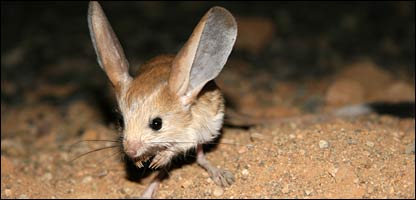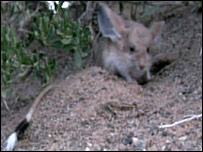
December 10, 2007

Long-eared Jerboa (Euchoreutes naso).
An “extraordinary” desert creature has been caught on camera for what scientists believe is the first time.
The long-eared jerboa, a tiny nocturnal mammal that is dwarfed by its enormous ears, can be found in deserts in Mongolia and China.
Zoological Society of London (ZSL) scientist Jonathan Baillie said the footage was helping researchers to learn more about the mysterious animal.
The species is classified as endangered on the IUCN Red list.
The unusual animals were filmed in the Gobi desert during an expedition led by Dr Baillie.Until now, the creatures had proven extremely difficult to study, thanks to their minuscule size, nocturnal nature and the harsh desert environment that they inhabit.
Big ears
Dr Baillie told BBC News that he was “ecstatic” to have tracked down the jerboas.
“These creatures hop just like a kangaroo; it is amazing to watch. Little hairs on their feet, almost like snow shoes, allow them to jump along the sand,” he explained.
“And in terms of mammals, they have one of the biggest ear-to-body ratios out there.”
The footage revealed that the creatures spend daylight hours burrowed down in underground tunnels beneath the sand, and that their diet was mostly made up of insects.
“The long-eared jerboa is a bit like the Mickey Mouse of the desert, cute and comic in equal measure,” Dr Baillie said.
By setting pitfall traps, the researchers were also able to look at the rodents close-up and to begin to estimate their population.
He added that although there was still much to learn about the rare rodent it was already believed to be under threat from habitat disturbance.
“We travelled to the Gobi to find out about the animal’s status and learn more about it so we can develop a thorough long-term action plan.”
Desert bounties
The expedition formed part of ZSL’s Edge programme, which focuses its efforts on conservation plans for animals that are both endangered and evolutionary distinctive.
The long-eared jerboa is one of 10 species that the programme is looking at this year.
Hopping about
“These amazing, remarkable creatures are on the verge of extinction and we know almost nothing about them,” warned Dr Baillie.He added that it was important not to overlook desert habitats in conservation.
“Everyone thinks the desert is a totally desolate area, void of biodiversity, and often when conservation planning is done, deserts are overlooked.
“But there are some remarkable species in the desert, so we really need to start paying attention to this environment.”
An Edge scientist has now been appointed to further study the species. ~ by Rebecca Morelle, BBC News, “Mysterious mammal caught on film.” 10 December 2007.

About Loren Coleman
Loren Coleman is one of the world’s leading cryptozoologists, some say “the” leading living cryptozoologist. Certainly, he is acknowledged as the current living American researcher and writer who has most popularized cryptozoology in the late 20th and early 21st centuries.
Starting his fieldwork and investigations in 1960, after traveling and trekking extensively in pursuit of cryptozoological mysteries, Coleman began writing to share his experiences in 1969. An honorary member of Ivan T. Sanderson’s Society for the Investigation of the Unexplained in the 1970s, Coleman has been bestowed with similar honorary memberships of the North Idaho College Cryptozoology Club in 1983, and in subsequent years, that of the British Columbia Scientific Cryptozoology Club, CryptoSafari International, and other international organizations. He was also a Life Member and Benefactor of the International Society of Cryptozoology (now-defunct).
Loren Coleman’s daily blog, as a member of the Cryptomundo Team, served as an ongoing avenue of communication for the ever-growing body of cryptozoo news from 2005 through 2013. He returned as an infrequent contributor beginning Halloween week of 2015.
Coleman is the founder in 2003, and current director of the International Cryptozoology Museum in Portland, Maine.
Filed under Breaking News, Cryptotourism, CryptoZoo News, Cryptozoologists, Cryptozoology, Expedition Reports, New Species, Photos, Videos